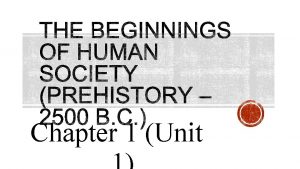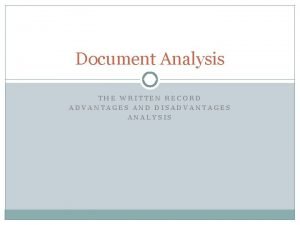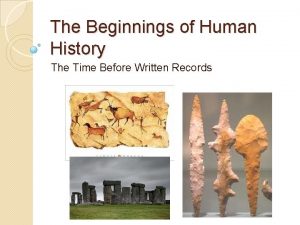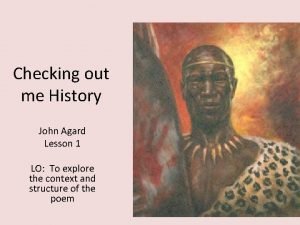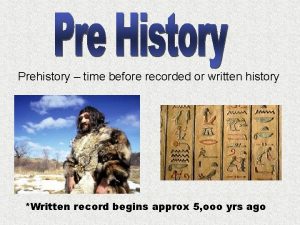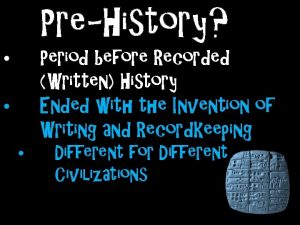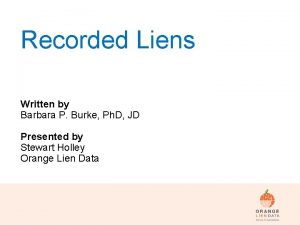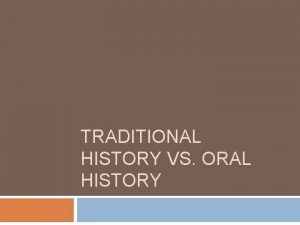Chapter 1 Unit History Written and other recorded














- Slides: 14

Chapter 1 (Unit

§ History: Written and other recorded events of people § Prehistory: Time before writing was invented § Archaeologist: A scientist who examines objects to learn about human past § Oral traditions: Stories passed down by word of mouth § Geography: The study of the Earth’s surfaces and the processes that shape it

§ Discovered in the Alps by two hikers in 1991 § The Iceman’s body and possessions were taken to a laboratory, where scientists learned more about him. § Clothing and tools provided clues to how the Iceman lived § Scientists determined that the Iceman lived about 5, 000 years ago. § Most important clue from the Iceman was his copper ax. § Copper was the first metal used by Europeans (beginning about 4, 000 B. C. ) § In many ways, the story of the Iceman helps us to understand the story of our past.

§ About 5, 000 years ago, people in Southwest Asia and in Africa developed systems of writing. § People keeping written records of their experiences marked the beginning of history! § Prehistory: The period of time before writing was invented. (The prefix “-pre” means before. ) § Archaeologist are scientists who examine objects to learn about past peoples and cultures. § They sift through the dirt of prehistoric areas to find bones, tools, and other objects. § EX: The size of a stone spear can show what kind of game the people hunted!

§Written records studied by historians often began as oral traditions, or stories passed down by word of mouth. § -Not all oral stories are historically accurate! § -Similar to myths and facts! Oral traditions can be mixed with personal beliefs and exaggerations.

§ Geography: The study of Earth’s surface and the processes that shape it. § Geography also refers to the features of a place, including: § -Climate § -Landscape § -Location § Knowing the connections between geography and history is often the key to understanding why events happened.

Stone Age: A period of time during which early humans made lasting tools and weapons mainly from stone; the earliest known period of human culture. Nomad: A person who has no settled home Fertile: Rich in the substances plants need to grow well; describes soil and land. Domesticate: To adapt wild plants for human use; tame wild animals and breed them for human use

§ -The first use of stone to create tools began the earliest known period of human culture: THE STONE AGE! § -Archaeologists divide the Stone Age into three periods: § 1. The Old Stone Age § 2. The Middle Stone Age § 3. The New Stone Age § -Almost all of prehistory took place during the Old Stone Age. (When early humans did not yet know how to farm!) § -Early humans discovered how to create fire. This was an important step for our human ancestors! They could now move to areas with colder climates. § -Many of our Old Stone Age ancestors were nomads, or people who have no settled home. Humans eventually spread out over much of the Earth!

§ The New Stone Age begin about 11, 000 years ago when farming was discovered in Southwest Asia. § Some places were better for farming than others. Soil in some areas was very fertile, or rich in the substances that plants needs to grow. § When people first began to plant crops, they carefully chose seeds from the biggest, best-tasting plants. In doing so, they began to domesticate plants, or adapt wild plants for human use. -During the New Stone Age, humans also learned to tame wild animals and breed them for human use. -EX: The people of Ancient India tamed wild elephants for use in battle.

§ Irrigation: Supplying land with water through a network of canals. § Surplus: More than is needed. § Artisan: A worker who is especially skilled at crafting items by hand. § Civilization: A society with cities, a central government, job specialization, and social classes. § Social Class: A group of people with similar backgrounds, incomes, and ways of living.

§ Farming techniques like irrigation were important in creating early communities. § Farming also meant people no longer had to travel from place to place! People often even had a food surplus, or more than what is needed. § Surplus food allowed families to have more children. Larger families brought rapid population growth! § Because of food surpluses, some people were able to switch from farming to other kinds of work. § EX: Artisans (A worker who is especially skilled in crafting items by hand. )

§Some of the earliest cities grew up along large rivers! §Nile in Egypt §Tigris and Euphrates in Iraq §Huang in China §Indus in Pakistan.

§ Over time, some New Stone Age societies grew into civilizations. § By around 3, 500 B. C. , some civilizations had developed a simple but amazing invention: the wheel and axle. § More trade goods could be loaded into carts and transported! § Growing trade links brought new prosperity to the cities. This led to development of social classes.

§ In large cities, the king was the most powerful person. § Next in importance were two classes of people: Priests and nobles (government officials and military officers) § Artisans, common workers, and farmers were the lowest ranked members of society. § Slaves, human beings owned as property by other people, formed a separate social class. Their status was beneath free people.
 Written and other recorded events of people
Written and other recorded events of people History of recorded music timeline
History of recorded music timeline Example of description
Example of description Cpmcd full form
Cpmcd full form Document analysis advantages and disadvantages
Document analysis advantages and disadvantages Recorded cash and credit card sales
Recorded cash and credit card sales Cash received journal
Cash received journal Types of repair
Types of repair Written records in history
Written records in history Written records in history
Written records in history Checking out me history context
Checking out me history context Neanderathal
Neanderathal Realistic fiction subgenres
Realistic fiction subgenres This meeting is being recorded
This meeting is being recorded This session will be recorded
This session will be recorded
